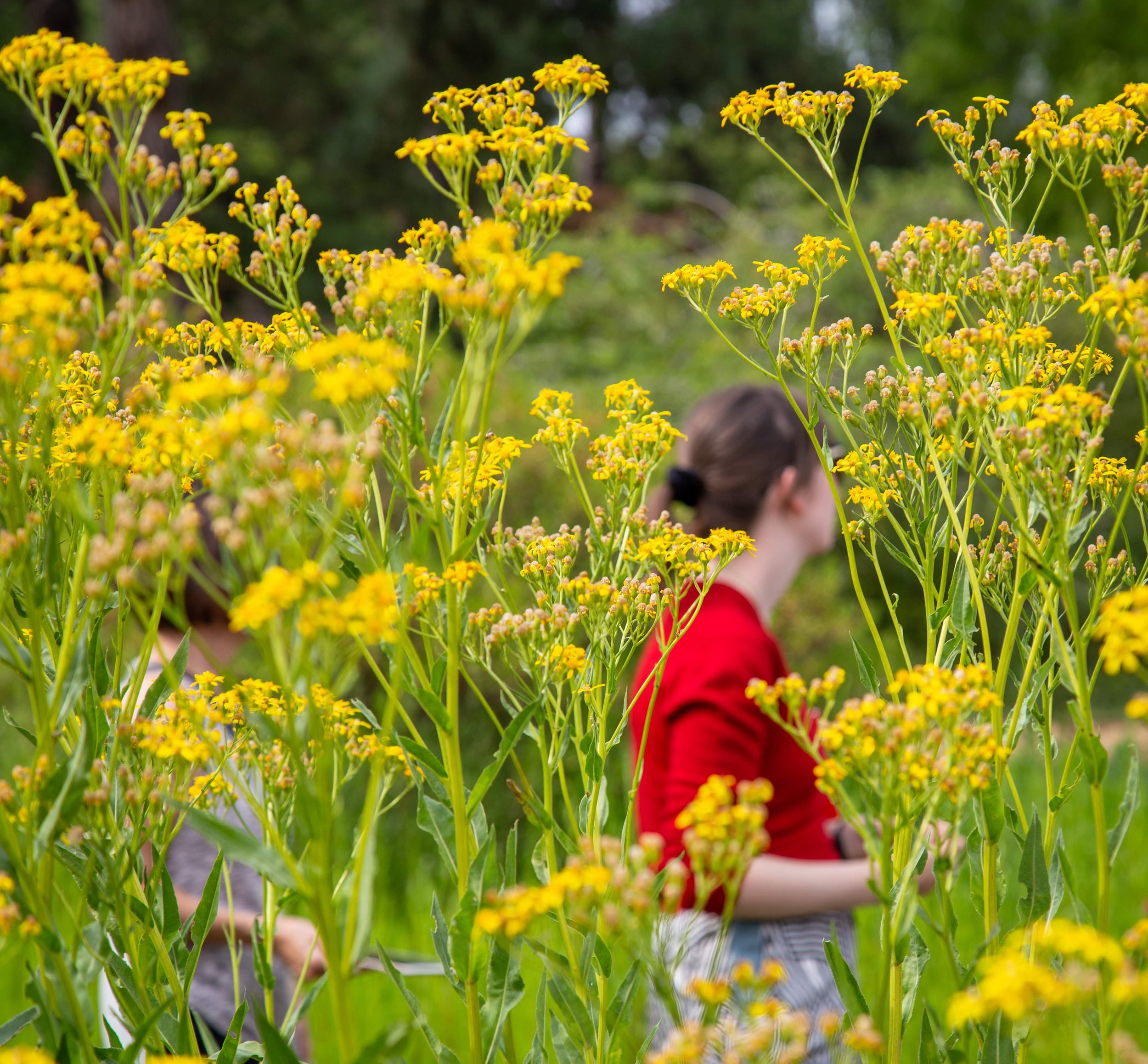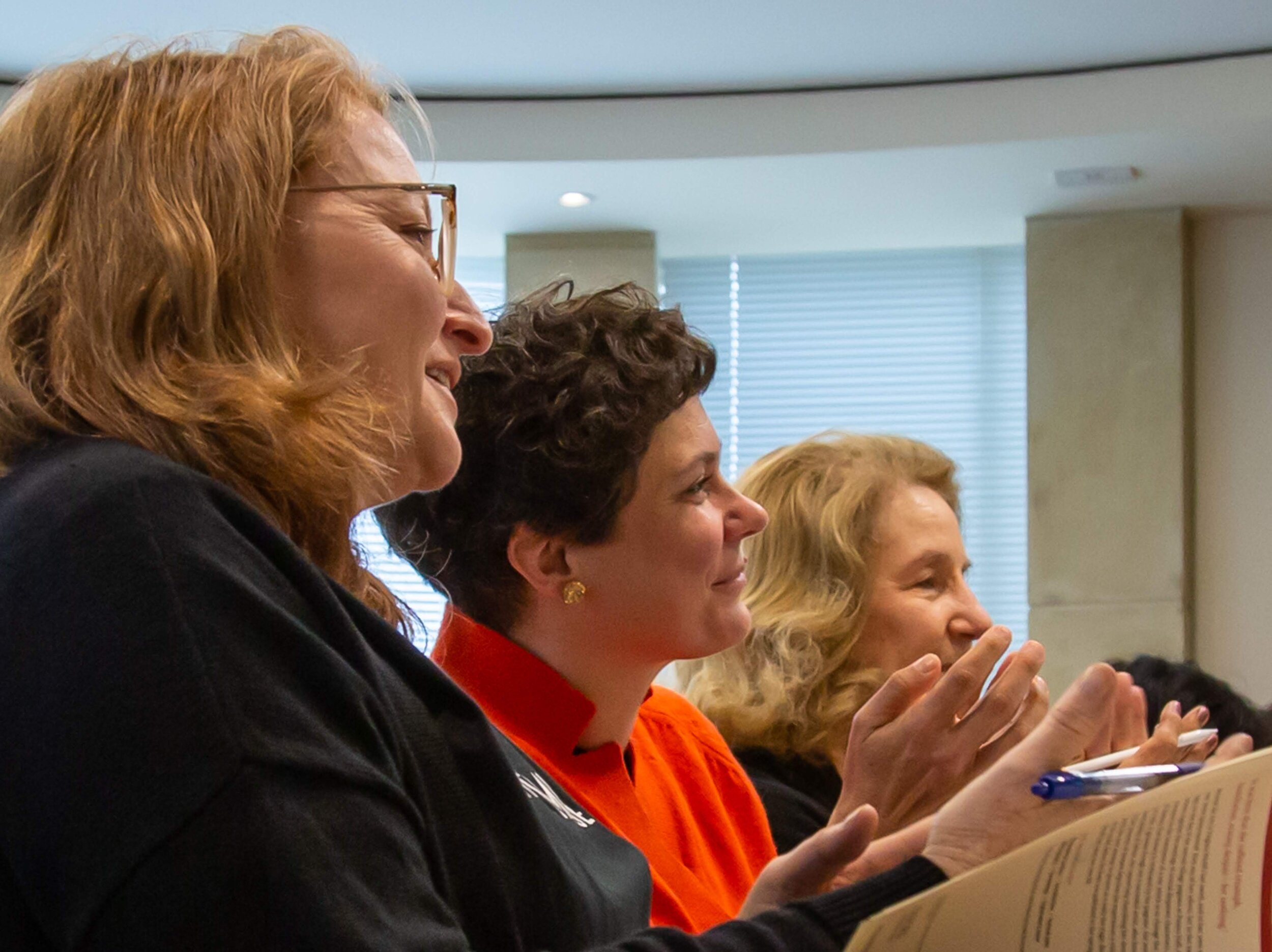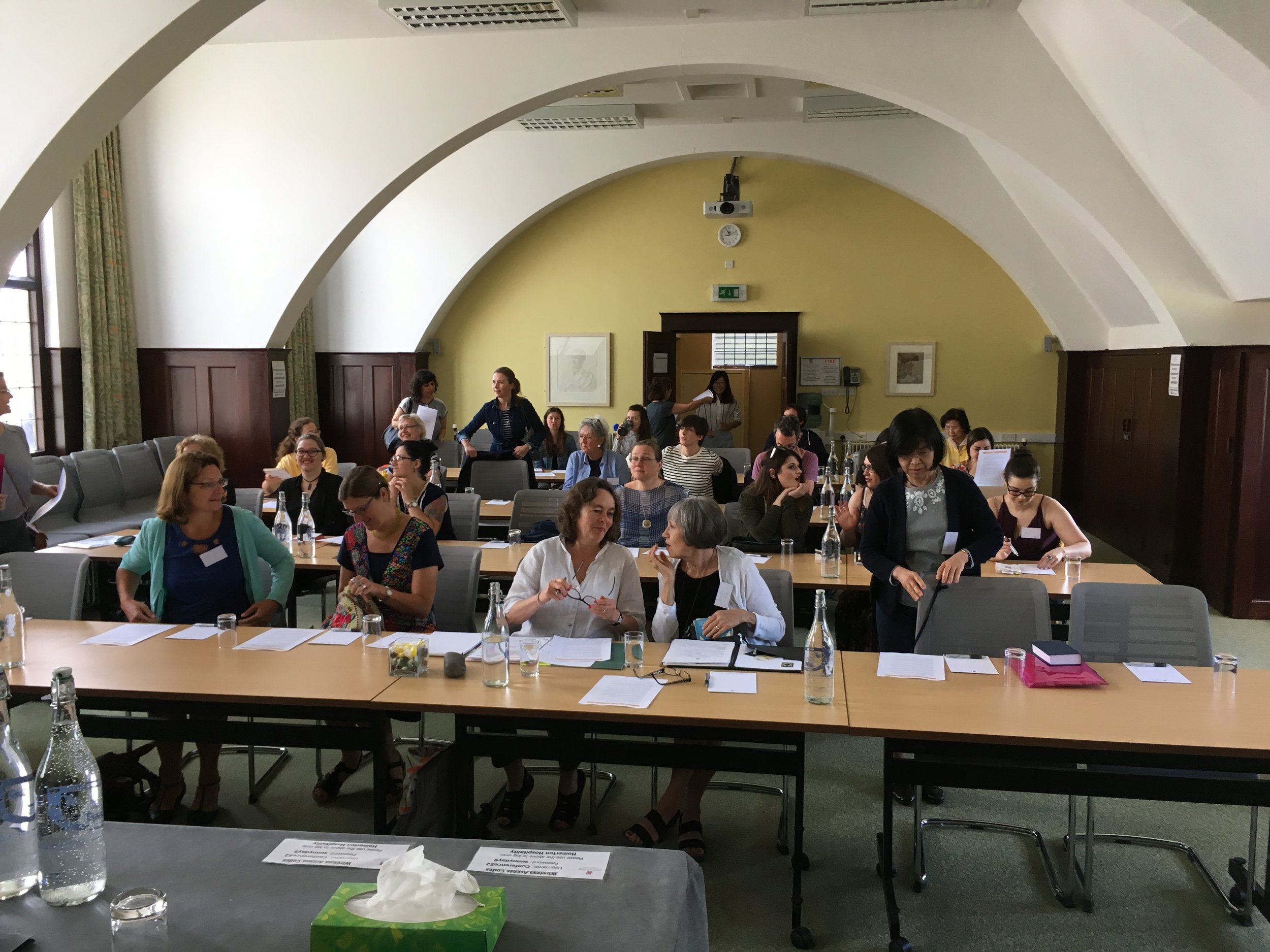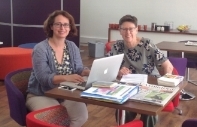
Past summer courses
Image: Jeremy Peters @jezpete
2023
Virginia Woolf’s Women
10-14 July 2023 Live online
24-28 July 2023, Clare Hall, Cambridge
Our 2023 Virginia Woolf course explored the theme of Woolf’s Women, looking at some of her fascinating women characters. These include Mrs Dalloway and her daughter; Mrs Ramsay and Lily in To the Lighthouse; plus the intriguing figure of Orlando, who leads us to wonder: What is a woman, to Woolf?
And what about the women in Woolf’s life who were so important to her writing: her mother Julia Stephen, her sister Vanessa Bell; friends such as writer Katherine Mansfield and composer Ethel Smyth; lover Vita Sackville-West? The course ran for 5 days live online, then two weeks later, it ran for 5 days in Cambridge. Classes were held at Clare Hall. Most participants stayed at Robinson College; a few stayed in hotels or Air BNB.
Lectures
• Monday. Ellie Mitchell, Mrs Dalloway and her Daughter (1925)
• Tuesday. Trudi Tate, Women in To the Lighthouse (1927)
• Wednesday. Alison Hennegan, What is a Woman: Orlando (1928)
• Thursday. Karina Jakubowicz, Women in A Room of One’s Own (1929)
• Friday. Claire Davison, Between the Acts (1941): Virginia Woolf and Ethel Smyth
Talks and readings
• Alison Hennegan on Girton College, the first women’s college in Cambridge
• Ann Kennedy Smith on Pernel Strachey, Principal of Newnham College and friend of Virginia Woolf
• Mathelinda Nabugodi on the manuscript of A Room of One’s Own at the Fitzwilliam Museum
• Susan Sellers on Woolf’s friendship with Lydia Lopokova
• Karina Jakubowicz, reading aloud from Woolf’s writing
Visits
For the course in Cambridge, we visited Girton and Newnham Colleges, the first women’s colleges in Cambridge. In 1928 Woolf gave a talk at both colleges which formed the basis of A Room of One’s Own (1929). We also visited the Fitzwilliam Museum to see the manuscript of this influential work.
2022
Virginia Woolf’s Houses
July 2022, Live online
2019
Virginia Woolf’s Gardens
14-19 July 2019, Wolfson College, Cambridge
'Everything tended to set itself in a garden where there was none of this gloom.'
– To the Lighthouse.
Gardens, parks, and plants are enormously important in Woolf's writings. When readers start looking for the gardens in her work they might feel, like James Ramsay in To the Lighthouse, as though ‘everything tended to set itself in a garden.’ It is a space that occurs in every single one of her novels and in several of her essays and short stories. This course explores why gardens were so important to Woolf, and asks how they affected her life and work.
At lecture, Woolf’s Gardens, Wolfson College
We studied works across the length of Woolf's career, from 'Kew Gardens' (1919) to Between the Acts (1941). What do gardens mean in her work; and how does this meaning deepen our understanding of her novels? We explored the roles played by individual plants and flowers in her fiction, and touched on early twentieth century gardening and design. Is there a politics or language of gardening; how does Woolf use gardens to explore some of her more challenging ideas?
Lectures
Shelf in Woolf’s bedroom, Monk’s House
Karina Jakubowicz, Introduction: 'Kew Gardens' and Mrs Dalloway
Alison Hennegan, Jacob's Room and A Room of One's Own
Trudi Tate, To the Lighthouse
Karina Jakubowicz, Between the Acts
Suzanne Raitt, Orlando and Knole
Charleston
Optional further reading
Quentin Bell and Virginia Nicholson, Charleston: A Bloomsbury House and Gardens (new edition, 2004)
Hermione Lee, Virginia Woolf (biography, 1995)
Caroline Zoob, Virginia Woolf's Garden: The Story of the Garden at Monk's House (2013)
Other talks
• Artist Kabe Wilson gave a talk on his remarkable creative work on Woolf, Of One Woman Or So.
• Garden historian Caroline Holmes guided us around Cambridge's Botanical Garden and talked about the Darwin connections.
• Jeremy Thurlow, Music Fellow of Robinson College, gave a lecture on Woolf’s interest in music, and gave a piano recital of some pieces that she loved.
• We had a guided tour of the gardens and buildings of King’s College and Newnham College.
Day trip
After the course, there was an optional trip to Charleston and Monk’s House in Sussex. Gallery.
Podcast
Hear Caroline Zoob, author of Virginia Woolf’s Garden, interviewed by Literature Cambridge lecturer Karina Jukubowicz.
From Leonard Woolf's autobiography of the years 1919-1939, Downhill All the Way (1967)
'I will end … with a little scene that took place in the last months of peace. They were the most terrible months of my life, for, helplessly and hopelessly, one watched the inevitable approach of war. One of the most horrible things at that time was to listen on the wireless to the speeches of Hitler — the savage and insane ravings of a vindictive underdog who suddenly saw himself to be all-powerful. We were in Rodmell during the late summer of 1939, and I used to listen to those ranting, raving speeches. One afternoon I was planting in the orchard under an apple-tree iris reticulata, those lovely violet flowers. … Suddenly I heard Virginia’s voice calling to me from the sitting room window: 'Hitler is making a speech.'
I shouted back, 'I shan’t come. I’m planting iris and they will be flowering long after he is dead.' Last March [1966], twenty-one years after Hitler committed suicide in the bunker, a few of those violet flowers still flowered under the apple-tree in the orchard.'
Useful links
Supervision, Woolf’s Gardens, Wolfson College
Virginia Woolf Society of Great Britain website.
Monk's House, National Trust website.
Charleston, National Trust website.
Paula Maggio, Blogging Woolf.
British Library information on Woolf's short story, 'Kew Gardens' (1919).
Paula Maggio, review of Caroline Zoob, Virginia Woolf's Garden, Blogging Woolf.
Review of Zoob, Virginia Woolf's Garden, Virginia Woolf Blog.
Review of Zoob, Virginia Woolf's Garden, Gardens Illustrated.
Review of Damon Young, Voltaire's Garden.
Notes on Leonard Woolf.
Jeanette Winterson on Orlando, Guardian, September 2018.
Margaret Atwood on re-reading To the Lighthouse, Guardian, September 2002.
Photos by @JezPete
Fictions of Home: Jane Austen to the Present Day
21-26 July 2019, Wolfson College, Cambridge
This course explored ideas of home in literature, from the early nineteenth century until today, from Jane Austen’s Pride and Prejudice and Northanger Abbey, through Charles Dickens, Katherine Mansfield, and Virginia Woolf, and ending with contemporary refugee writers.
How does the modern idea of 'home' emerge in the writings of Jane Austen; when does a house become a home? What does 'home' mean in Dickens’s powerful autobiographical novel, David Copperfield (1850)? In the early twentieth century, how does Katherine Mansfield understand 'home' in her innovative and moving short stories; and what does it mean in Virginia Woolf's great novel, Mrs Dalloway (1925)? And finally, we explored how writers in our own time discuss the terrible loss of home faced by refugees. We studied Vietnamese-American Viet Nguyen’s powerful story collection, The Refugees (2017) alongside anthologies of British and international refugee writers, Refugee Tales and The Displaced. Our teachers included Oliver Goldstein, Alison Hennegan, Isobel Maddison, Jane Potter, Corinna Russell, Clare Walker Gore, and Trudi Tate.
A really interesting group of people came to the course from many different parts of the world – Canada, Belgium, Switzerland, Spain, Britain, the US, Australia, Sweden, Turkey, Ireland, Japan, and France – bringing a wealth of reading and experience to our discussions. We gained new insights into some great writers of the past 200 years, and we learned more about how literature bears witness to one of the great themes of our time: the meanings of home.
Lecture list
• Alison Hennegan on Austen, Northanger Abbey (written 1798; published 1817) and Pride and Prejudice (1813)
• Corinna Russell on Dickens, David Copperfield (1850)
• Jane Potter on Woolf, Mrs Dalloway (1925)
• Isobel Maddison on Katherine Mansfield, short stories (mainly 1920s)
• Trudi Tate on Viet Nguyen, The Refugees (2017); Viet Nguyen, ed., The Displaced: Refugee Writers on Refugee Lives (2018); and David Herd and Anna Pincus, eds., Refugee Tales (2016)
Ann Kennedy Smith, evening talk: ‘The women who changed Cambridge: Anne Clough, Ida Darwin and Helen Gladstone’:
Ann writes: ‘For hundreds of years Cambridge was an all-male institution. Then in the 1870s and 1880s the first women students and university wives arrived, and changed everything. Virginia Woolf once called Cambridge ‘that detestable place’, but these women's influence went beyond college walls. This talk will focus on Anne Clough, Ida Darwin and Helen Gladstone, whose work connected town with gown.’ Part of Ann’s talk on Ida Darwin is published on our blog page.
Poetry reading: Oliver Goldstein read Tennyson’s poem Maud (1855) in its entirety. This extraordinary work is written in the voice of a young man who feels out of place in his homeland (mid-nineteenth century England). It’s a story of love found and lost; of hope and delusion; of homeland and homelessness. The reading took about an hour.
We visited Kettle’s Yard House, where we heard a talk by Elliot Harris from CamCrag, a local charity which provides blankets, food and other assistance to refugees in Calais and elsewhere.
Blog posts about Fictions of Home
Mary and Melanie Cummings from Canada.
Francine Danniau from Belgium.
Jane Hills from the UK and US.
Useful links
British Library information on Jane Austen.
Reading of Tennyson’s Maud on YouTube.
Katherine Mansfield Society webpage. Includes copies of Mansfield's stories.
Virginia Woolf Society of Great Britain webpage.
Viet Nguyen, New York Times article, September 2016, on being a refugee.
Interview by Piper French with Viet Nguyen, Asymptote journal, April 2019.
Extract from Lyndsey Stonebridge’s essay on creation and de-creation in refugee studies.
Lecture by Viet Nguyen at Memory Studies Association conference, Madrid, 2019.
Kettle’s Yard photo by Jeremy Peters @JezPete
Women writers: Emily Brontë to Elizabeth Bowen
8-13 July 2018, Homerton College, Cambridge
This course studied five great women writers working in Britain in the nineteenth and early twentieth centuries. We focused on one book per day, with lectures, discussions, and supervisions (tutorials) in the Cambridge style.
Our teachers include leading scholars Gillian Beer, Aoife Byrne, Claire Davison, Alison Hennegan, Trudi Tate, and Clare Walker Gore.
'We think back through our mothers, if we are women', wrote Virginia Woolf in A Room of One's Own (1929). But is this always true? Woolf herself read deeply and widely across all of English literature, and by no means restricted herself to writing by women. But she, like other major women writers of the 19th and early 20th centuries, perhaps enabled more women to take themselves seriously as writers, and to commit themselves to the highest standards of literature.
Is there a 'women's tradition' in English Literature – a literature of one's own? Are these helpful ways of thinking about writing by women, or is it better to consider women, like men, in their full cultural and historical context?
We explored these and many other questions through five major works by women writers. They are all wonderful books in their very different ways, and they raise questions and ideas which remain relevant to everyone, women and men, writers and readers, right up to the present day.
Lecture List
Alison Hennegan on Emily Brontë, Wuthering Heights (1847)
Clare Walker Gore on George Eliot, The Mill on the Floss (1860)
Trudi Tate on Virginia Woolf, To the Lighthouse (1927)
Claire Davison on Katherine Mansfield, The Garden Party and Other Stories (1922)
Aoife Byrne on Elizabeth Bowen, To the North (1932)
Excursions
Visit to Wren Library
We had some wonderful visits to places of interest around Cambridge. We went to Girton College, established in 1869, the first residential university college for women. Clare Walker Gore talked about George Eliot’s support for women’s education, and Alison Hennegan told us some of the remarkable history of Girton. The talks were held in the Reception Room, where Woolf gave a talk in 1928 on 'Women and Fiction', which became A Room of One's Own (1929). Part of Clare's talk is on our Blog page.
We visited the Wren Library at Trinity College to see some of its manuscripts – Milton’s ‘Lycidas’; letters from Charlotte Bronte, George Eliot, and others; many first editions of classic works; not to mention the manuscript of Winnie the Pooh. And we had a traditional afternoon tea at the Orchard Tearoom in Grantchester, sitting under the apple trees.
Links
Clare Walker Gore's thoughts on George Eliot, The Mill on the Floss, on our Blog page.
Claire Davison's thoughts on Katherine Mansfield and music on our Blog page.
Robert McCrum on Wuthering Heights in the Guardian (16 December 2013)
Kathryn Hughes on The Mill on the Floss in the Guardian (27 March 2010)
British Library entry on Katherine Mansfield, The Garden Party (brief but useful)
Katherine Mansfield Society (UK).
Lucy Delap: brief comments on the Cambridge women's colleges and the women's suffrage movement (podcast).
Click for gallery of images from our 2017 summer course.
Read an account of the 2018 Women Writers course by Julia Salmeron of Madrid.
Read accounts of studying in Cambridge by PhD student Selin Kalostyan, and by Hans Grietens and Adam Chugg.
Woolf and Politics
1-6 July 2018, Wolfson College, Cambridge
Virginia Woolf lived through exciting, often turbulent times. This course explored how is the history of her own times is expressed in her writing. In her lifetime, women were newly able to study at university. Girton and Newnham Colleges were founded in Cambridge not long before she was born.
Woolf was in her 30s during the First World War. She was 36 when the first women got the vote in Britain, in 1918. She wrote about the laws which opened up the professions to women. She was closely engaged with people active in the Labour Party in the 1920s and 30s (including her husband, Leonard Woolf), and followed current events closely in the newspapers. She was a deeply committed anti-fascist, even as she wondered about the best way to oppose fascist thinking and behaviour. Her great work Three Guineas (1938) is both anti-fascist and a complex argument against war. The course looked at her experiences as activist, ambivalent commentator, and observer, and finished with her satiric look at gender in Orlando.
Lecture list
Frances Spalding
Peter Jones, Politics in the Essays of Virginia Woolf and Leonard Woolf
Alison Hennegan, A Room of One's Own and Women's Education
Frances Spalding, Three Guineas and the Spanish Civil War
Trudi Tate, The Times and The Years
Clare Nicholson, The Politics of Clothing in Orlando
Excursions
Visit to Wren Library
• We visited King's College with King's Fellow Peter Jones, to see parts of the college of interest to Woolf, including the chapel where she enjoyed the music. We were able to visit many parts of the college not normally open to visitors. More on our Blog pages.
• We went to the Wren Library at Trinity, mockingly cursed by Woolf in A Room of One's Own, and now much used by women scholars and students. It was fascinating to see letters from Virginia and Leonard Woolf, first editions of her work, as well as a display about the suffrage struggle.
• We enjoyed the rare opportunity to see the manuscript of A Room of One's Own at the Fitzwilliam Museum (not to mention the slap-up tea at Fitzbillies afterwards). See Blog pages for images.
Links:
Lizzie Hammond writes about the course.
Beatrice de Pauw writes about the course.
Jennifer Ristau writes about the course.
2017
Woolf's Rooms
16-21 July 2017, Homerton College, Cambridge
The theme for our 2017 Virginia Woolf Summer Course was Woolf's Rooms. We had an amazing week of intensive lectures, supervisions, discussions, and readings. We paid visits to Girton and Newnham Colleges, and heard about the talks Woolf gave there. These talks were then revised to become A Room of One's Own (1929), one of Woolf's most influential books. It was moving to sit in the very rooms in which Woolf spoke to young women undergraduates in 1928. We also went to King's College and to the Fitzwilliam Museum, where we were privileged to see the original manuscript of A Room of One's Own.
Sincere thanks to our inspiring teachers, and to our wonderful, enthusiastic students of all ages, from all over the world, who made this such a memorable week.
Course description
Why are rooms so important in the writing of Virginia Woolf? Who needs a room of their own, and why? The use of space was, and remains, a political issue. Who has space; how is it used; how is it shared (or not)? What is the relationship between rooms and creativity; rooms and power? The course explored these and many other questions through five key books by Woolf, listed below.
Our speakers included leading scholars Gillian Beer, Sinead Garrigan Mattar, Alison Hennegan, Claire Nicholson, Jane Potter, and Trudi Tate. Some evenings we had readings and talks, including a talk by Kabe Wilson on his remarkable re-writing of A Room of One's Own. Interview with Kabe Wilson here; article here. Thanks to all our speakers and to our wonderful supervisors, Alison Hennegan, Nadine Tschacksch, and Clare Walker Gore.
Selin Kalostyan writes about this course.
Reading list
A Room of One's Own (1929)
Jacob's Room (1922)
The Waves (1931)
To the Lighthouse (1927)
Between the Acts (1941)
Reading Bloomsbury
23-28 July 2017, Homerton College, Cambridge
Reading Bloomsbury explored some of the literature, art, and ideas developed by a lively group of intellectuals, many with strong Cambridge connections, who lived in Bloomsbury in London from about 1904. The course offered itself as an antidote to some current views of Bloomsbury; we focused on the work and ideas (rather than the love affairs) of these very interesting people, from whom we can still learn a great deal.
At Gordon Square, Bloomsbury
The loose grouping of people around Virginia and Leonard Woolf, Vanessa Bell, John Maynard Keynes, Roger Fry, Lytton Strachey, E. M. Forster, and others, were serious writers, artists, and thinkers. They were people who engaged seriously with the pressing political and social issues of the day, focusing on the 1910s to 1930s. We explored their thinking on some of the most important issues of the period, such as the First World War and the peace settlements, international relations, the franchise, the problems of an unreliable press, rights for women, freedom from sexual repression, the emergence of fascism.
Lecture list
Frances Spalding, Cambridge and Bloomsbury
Alison Hennegan, Sexual Politics: Lytton Strachey, E. M. Forster and others
Claudia Tobin, Vanessa Bell and Bloomsbury art
Claire Nicholson, Virginia Woolf, Mrs Dalloway (1925): women, clothing, and Bloomsbury aesthetics
Peter Jones, Bloomsbury, Pacifism, and Politics: Maynard Keynes, Leonard Woolf, Clive Bell, E. M. Forster
Thanks to all our lecturers, and to our supervisors Alison Hennegan and Nadine Tschacksch.
Selected reading
Virginia Woolf, 'Old Bloomsbury' (1928) in Moments of Being
E. M. Forster, 'What I Believe' (1939). Online edition.
Frances Spalding, The Bloomsbury Group(2013)
Links:
Ian Sansom article in the Guardian on Bloomsbury (2011).
Susanna Rustin article in the Guardian on Bloomsbury (2015).
Extract from Glendinning biography of Leonard Woolf in the Guardian (2006).
Paul Levy review of Glendinning's biography of Leonard Woolf (2006).
Paul Levy on Lytton Strachey in the Guardian (2002).
Art UK on Vanessa Bell.
Art UK on Dora Carrington.
Art UK on Roger Fry.
For students' comments on this course, please see the Testimonials page.
2016
Virginia Woolf in Cambridge
July 2016, Homerton College
Our first course was Virginia Woolf in Cambridge, held 17-22 July 2016 in Homerton College, Cambridge. We started each day with a lecture and discussion by a leading Woolf scholar. We heard Alison Hennegan on A Room of One's Own, Susan Sellers on Mrs Dalloway, Trudi Tate on To the Lighthouse and Gillian Beer on Reading The Waves Across a Lifetime. We also looked at some of Woolf's essays, and deepened our knowledge of the context in which she wrote. We thought about Woolf's own education, which was mainly (not entirely) at home. She was extraordinarily well read and well informed. Much of her knowledge came through her own reading, much from intellectual discussions with others. At the same time, she recognised the value of formal education. We visited Girton and Newnham Colleges and sat in the very rooms in which Woolf gave the talks in 1928 which were to become A Room of One's Own.
Most days we had what in Cambridge is called a supervision (in Oxford it is a tutorial). A small group of 2 or 3 students talks for an hour with an experienced Cambridge supervisor. It is an opportunity for an open yet guided discussion, in which students explore ideas quite deeply, listen carefully to other people's thoughts, and develop their skills in reading a literary work in depth, and with precision. Our supervisors were Alison Hennegan, Nadine Tschacksch, and Clare Walker Gore.
We had an excursion to the Orchard Tea Room in Grantchester and heard a talk by Claire Nicholson on Woolf's friendship with Rupert Brooke before the First World War, and we visited Bloomsbury in London, led by art historian Claudia Tobin. We enjoyed readings and talks by novelist Susan Sellers and performance artist Kabe Wilson. Throughout the week, students used their spare time to read, think, visit bookshops and colleges, discuss ideas with other students, and to reflect.
One of our students, Adam Chugg, gives further thoughts on the course on our Blog. Another student, Beth Daugherty, has written an account for Blogging Woolf.
For us, one of the most rewarding aspects of the course was the incredibly interesting group of people who came to Cambridge from many parts of the world. Woolf brought together readers who would never otherwise meet, and many strong friendships were formed.
Visit to Bloomsbury, 2016.
Students' comments on Woolf summer course 2016:
This summer course is one of my top experiences.
The course is still resonating – I think it was the immersion. The course was a real inspiration.
Terrific program. I am going to do my best to come back next year ... You did an exceptional job providing something for everyone, no matter their background. A big thank you.
Thank you so much for this course. It was excellently run and has reinvigorated both my enthusiasm for the Cambridge way and, most importantly, for Woolf’s works.
Very well organized, enthusiastic staff, diverse range of activities, wonderful location! Thanks for everything!
Clear speakers whose enthusiasm is engaging and stimulating.
Further comments.


















